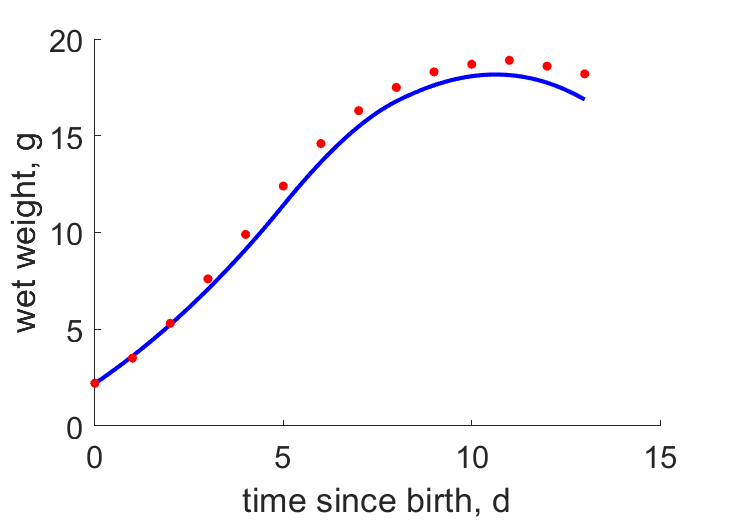Predictions & Data for this entry
| Model: std | climate: A, B, C, D | migrate: | phylum: |
| COMPLETE = 2.5 | ecozone: THp, TPi | food: biCi, biHs | class: |
| MRE = 0.034 | habitat: 0iTh, 0iTi, 0iTs, 0iTg, 0iTa | gender: Dg | order: |
| SMSE = 0.002 | embryo: Tnwf, Tncf | reprod: O | family: |
Zero-variate data
| Data | Observed | Predicted | (RE) | Unit | Description | Reference |
|---|---|---|---|---|---|---|
| ab | 13 | 13.79 | (0.06061) | d | age at birth | AnAge |
| tx | 14 | 14.57 | (0.04085) | d | time since birth at fledging | PinoBerk2004 |
| tp | 42 | 43.15 | (0.02746) | d | time since birth at puberty | guess |
| tR | 319 | 319 | ( 0) | d | time since birth at 1st brood | AnAge |
| am | 4782 | 4987 | (0.04293) | d | life span | AnAge |
| Wwb | 2.2 | 2.181 | (0.008697) | g | wet weight at birth | PinoBerk2004 |
| Wwi | 25 | 25.23 | (0.009075) | g | ultimate wet weight | PinoBerk2004 |
| Ri | 0.03425 | 0.0325 | (0.05108) | #/d | maximum reprod rate | AnAge |
Uni- and bivariate data
| Data | Figure | Independent variable | Dependent variable | (RE) | Reference |
|---|---|---|---|---|---|
| tW |  | time since birth | wet weight | (0.05091) | PinoBerk2004 |
Pseudo-data at Tref = 20°C
| Data | Generalised animal | Passer montanus | Unit | Description |
|---|---|---|---|---|
| v | 0.02 | 0.0281 | cm/d | energy conductance |
| p_M | 18 | 1352 | J/d.cm^3 | vol-spec som maint |
| k_J | 0.002 | 0.05671 | 1/d | maturity maint rate coefficient |
| k | 0.3 | 0.3071 | - | maintenance ratio |
| kap | 0.8 | 0.8474 | - | allocation fraction to soma |
| kap_G | 0.8 | 0.8001 | - | growth efficiency |
| kap_R | 0.95 | 0.95 | - | reproduction efficiency |
Discussion
- Feeding is reduced towards end of nestling period
- mod_1: v is reduced
- mod_2: Pseudo-data point k is used, rather than k_J; Data set tp and parameter t_R are added, the latter replacing clutch interval t_N. Postnatal T is based on PrinPres1991, see get_T_Aves. See further the revision page, theme puberty
Bibliography